As you may remember, eleven years ago a group of friends and I bought a five acre island near Halifax, Nova Scotia. We only visit it a few times per year, but those visits are the perfect counterbalance to spending too much time in front of the computer and away from nature.
Progress at the island is best characterized as two steps forward, one step back. So when we weren’t able to go to Canada for three years due to Covid, we just took three steps back. The most urgent issue was that a hurricane destroyed the dome cap of our yurt, but it wasn’t the only problem. The even bigger problem, one that had been brewing for a long time, was that the vinyl roof of our yurt was failing. Small holes had appeared, which the wind whipped into small gashes. Every storm poured gallons of water into the yurt.
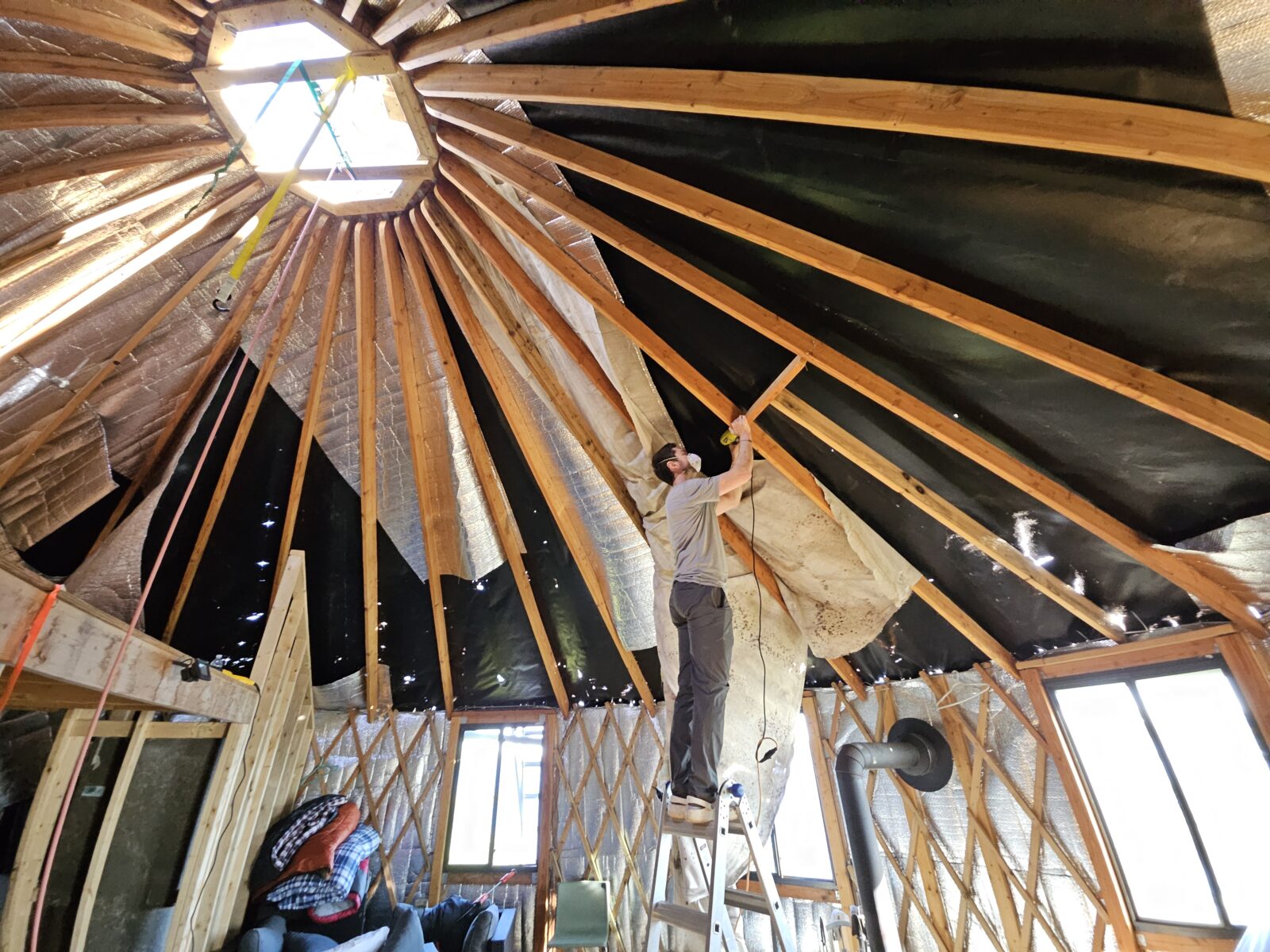
The most fun island trips are where there are lots of projects to do, but none of them are urgent. The most stressful are the ones where something absolutely has to get done, because there are always unexpected roadbumps, and being on an island makes everything more complicated.
Earlier this year Brian and I decided that the roof project couldn’t wait and we had to come up with a plan for a rigid wooden roof. As far as I could tell, no one had ever done this on a yurt, or at least no one had explained how they had done it, so we were on our own. We tried to rally other island owners, but no one volunteered to help us. Luckily Brian’s friend Andy volunteered, and even better, decided to drive from Montreal with a bunch of tools.
Brian and I met in his apartment to sketch out a plan. The yurt is about thirty feet in diameter and has thirty-two rafters. We determined that with a bit of clever cutting, we could fill each “pie wedge” with an upper and lower piece of wood, and we could cut those two pieces from just one piece of plywood. Easy! We ordered the wood as well as many gallons of rubber roof coating, and felt ok about the trip. To make things even easier, we would just leave the existing vinyl roof underneath the wooden one, so at no point would we have to expose the interior to the weather.
Roof Trip 1
It took a few days to get the lumber over, prep, clean up the yurt a bit, remove the old (now very moldy) cotton lining, and get ready. We had a big argument over the best way to do things. I wanted to figure out the average dimensions for a wedge, and assembly line build them. Then we’d move each rafter into position to form that size wedge. At the end we’d probably be off by a bit, so we’d do a custom one.
Brian wanted to do custom ones for every single wedge (though he also wanted to move the rafters somewhat to make them even). I convinced him to just try my way, since it would be the fastest if it worked, and we pretty immediately realized that it wouldn’t work. First, we have framed windows and doors and we can’t put rafters on top of them. So that limits the placement of several rafters. But it also limits the placement of rafters between the windows and doors because you want things to be roughly equal in those spaces. We divided the yurt into sections (door to first window, first window to second window, etc) and came up with standard sizes for each of those. But then as we began to move the rafters into place we discovered another problem— we couldn’t just place rafters wherever we wanted to. The rafters latch on to an aircraft cable that circles the yurt and is rested on the lattice that forms the walls, but the lattice sticks up and you can’t put a rafter directly on it.
So we had to measure each one individually. You would think this wouldn’t be THAT hard, since you really only need a couple measurements, but after putting up a few we realized that the bottom edges weren’t lining up. It turns out that the top ring disaster from the year before had skewed the top ring relative to the bottom ring, so now the wedges were no longer isosceles triangles, but actually had different dimensions on each side. To make an extremely long story a bit shorter, we ended up having to get on the roof and measure five dimensions for each panel, and then we made a cad model so that we could plug those numbers in and get our cuts. Then we had to make those cuts basically perfectly because we didn’t have any extra wood (it’s hard to dispose of pressure treated plywood and annoying to carry).
As you can imagine, this took forever.
Getting the panels onto the roof was also a challenge. Our first method involved leaning a ladder against the side of the yurt with me pushing the wood up and the other two guys supporting on the side. We failed to consider the lever action that would take place when the wood flopped down onto the roof and lifted my arms up. In an instant I realized that if I didn’t let go I was going to be pushed backwards off the ladder so I pushed the wood to the side and let it fall in the woods behind me. It nicked me in the neck. Brian and I, used to these sorts of janky setups, just started thinking about our next try. His friend Andy, who is a bit more safety minded than us, took a walk to decompress because, as he said, “I think I just saw you almost get decapitated”. To be fair, I think it looked a lot worse than it was, but I get it. Eventually we got climbing gear from Halifax and hoisted each panel up.
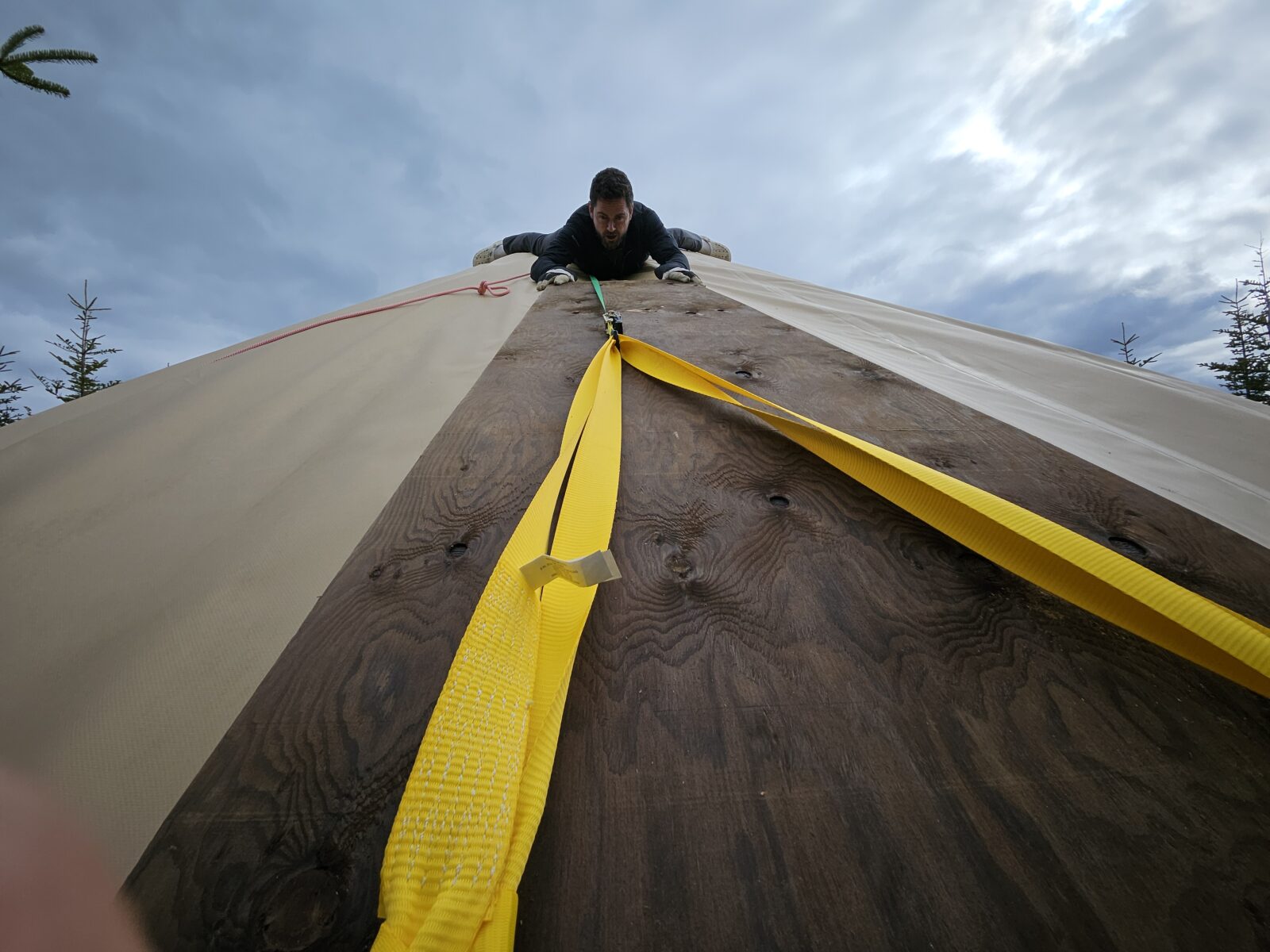
Over the course of our ten day trip we were making progress, but also slipping behind every day. When we first arrived we had grand dreams of installing skylights. Then we settled on just coating the roof with the rubber. Then just getting the panels up, and finally just getting most of them up.
I have never been more tired in my life. My whole body ached with every movement. We’d take a bit of time for a quick tea in the morning and lunch around noon, but besides that we were working all daylight hours and some evening hours if there was stuff we could do inside. By the last day we had gotten the whole bottom ring of panels installed but still had to do the top ones. I was pretty defeated and suggested to Brian that we work until 11pm and then just call it. He agreed, but then said that he’d stay up a bit later and try to get some more done by himself. By the time I woke up the next morning and got to the yurt I could see that he did almost all of the top panels. He had stayed up until 4am and then woken up at 7am again to put up a few more. The main reason he couldn’t do the last four is that our cell service at the island had degraded over the past couple years, and the CAD software we were using was online. He couldn’t even connect to it.
We were happy with our progress, given the difficulty, and felt like we were a bit out of the woods. We left the yurt in total disarray, as we hadn’t allocated time to cleaning in 4-5 days and had been using the main area to cut the smaller pieces of wood.
Some of my enthusiasm evaporated when I reported my progress to my dad and uncle, and both of them told me that pressure treated wood really shouldn’t be left to the elements. I thought that was the whole point, but had never actually looked it up. I was nervous about we’d find when we returned.
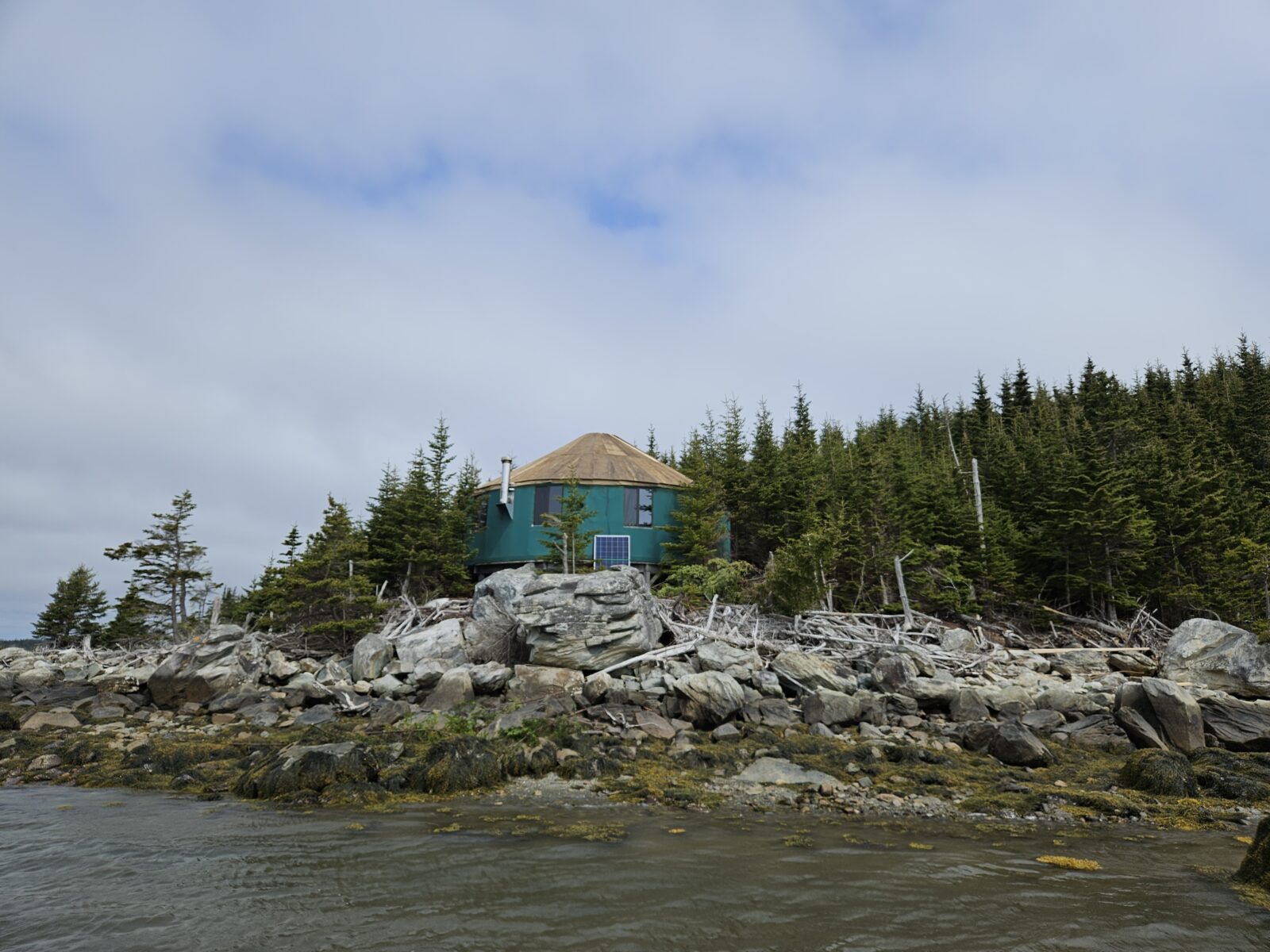
Roof Trip 2
We marshaled a bit more help for the second trip. Fellow island owner Ben and his wife Mai came to help as well as my good friend Todd. Neither Ben nor Mai had much experience with construction, but I know Ben to be a relentless hard worker, and Mai seemed very eager as well. Todd is a frequent island visitor and is both competent and very hard working.
The nice thing about having more than two people is that you get quality of life projects done as well as urgent ones. Several steps of the roof only needed 2-3 people, so we would split into groups and get other things done as well.
Brian and I had framed walls for the indoor shower a couple years prior, but had never paneled the walls, even though we had already brought over the plywood. We got those paneled, even though an insane colony of carpenter ants had made a tunneled nest in the stack of wood, which was quite a shock.
We cleaned and organized the entire yurt, rewired some of the electronics, reinforced all of the rafters with vertical studs of the same length, so that the roof would be level, rebuilt parts of the outhouse and added a pee diverter, tiled the bathroom floor, and a ton of other projects. But… I’ll tell you about the one that made the biggest difference.
As I’ve mentioned before our neighbors on the mainland are truly the most kind and generous people I’ve ever met. It’s no exaggeration to say that every time I go to the island I am inspired by them to be a better person. They have helped us in so many ways over the years, and when we thank them or try to do anything to pay them back they act like we’re crazy because they’re just “doing what anyone would do”. Despite them constantly telling us to ask them if we need anything, I try to only ask if something’s important, because I don’t want to bother them.
Our cell service was excellent for years, but as far as I can tell the closest cell tower was removed during covid, and now it’s basically unusable. We looked into starlink but it was expensive to keep it on all year for the 2-3 weeks we’re at the island, and it uses so much power that we’d have to upgrade batteries significantly. I knew that point-to-point wireless links existed and seemed to be good, and when I mentioned it to the neighbors they said, “Oh yeah, of course you can do that”.
I ordered a set to bring to the island and they were way bigger than I thought and there was no way around drilling a hole through the side of the house to install it. I almost gave up on the idea because it felt like a huge ask, but I figured I’d at least show the setup to them and make it very easy for them to say no.
My pitch went something like, “I think this is a crazy big request, so please feel totally ok saying no, but here are these internet…”
“Whoa! You could get internet at the island? We can definitely do it!”
Such is their kindness that I think they may have been more excited for us to get internet than we were… and we were very excited.
Because of line of sight, we actually had to install the transmitter on a two-family house occupied by their parents and cousins. I know the parents well (and they have similarly saved us / helped us many times), but had only met the cousins once because I had lumber shipped to their driveway.
The parents were completely onboard with the idea. I was nervous about drilling a hole in their house, but the father found a long drill bit and drilled the hole before I could even say anything about it. They had an old pole mount set up for some antiquated internet system, so I mounted the transmitter to it. We went inside, cut some ethernet cables, and connected it to the router and power injector.
I sped the boat back, hooked up the receiver and… it didn’t work. The interface was clunky so it wasn’t completely obvious what was going on, but as best I could tell the transmitters could see each other but the sender didn’t seem to be connected to the internet. After exhausting every solution that didn’t involve driving the boat back over, I was left thinking we probably made a bad cable from the router to the transmitter.
I knocked on the door and the cousin who I didn’t know answered the door. He wasn’t home when I was doing the install earlier, so I didn’t know if he even knew about it. He let me in, and I saw that I was interrupting his family watching a movie together. I apologized and replaced the cable, and he came outside with me while I was checking some settings on the transmitter.
“I’m so sorry again to bother you guys. We really appreciate everything you and your family do for us and I wish that there was something we could do to repay you guys for all of your kindness.”
“Oh, you guys are like family to us! You’re a big part of our community here, and our house is your house. You can sleep here if you want! We’ll be out later but we’ll leave the back door unlocked in case you need to do anything else.”
Months later I’m still in awe of how he treated me, someone he’d only briefly talked to once while I was using his driveway as a staging ground.
I got back to the island and the internet was incredibly fast, as if we had a wired connection directly. Super low ping and about 35 megabit download speed. That night we ate in the yurt and all relaxed on the couch catching up on all of the stuff we hadn’t been able to do all week. When we went back to the mainland the next day every family member asked us if the internet worked and celebrated with us as if they were the ones getting internet for the first time.
My cabin is about 250 feet from the yurt and couldn’t receive the wifi signal. The next day we didn’t need everyone on the roof and Mai asked if there was anything she could do. I said if she wanted to she could blaze through the woods in a beeline for my cabin and run an internet cable for me. She put on a full body rainsuit she got at walmart and headed out to the wet forest. Up on the roof I forgot about her, so I was surprised when I saw her emerge from the woods an hour later looking like she’d been in a fight with a velociraptor. Her suit was shredded from the thick forest and she had a big smile on her face from accomplishing the mission. That night my tiny 5 watt router broadcast the second wifi signal on the island.
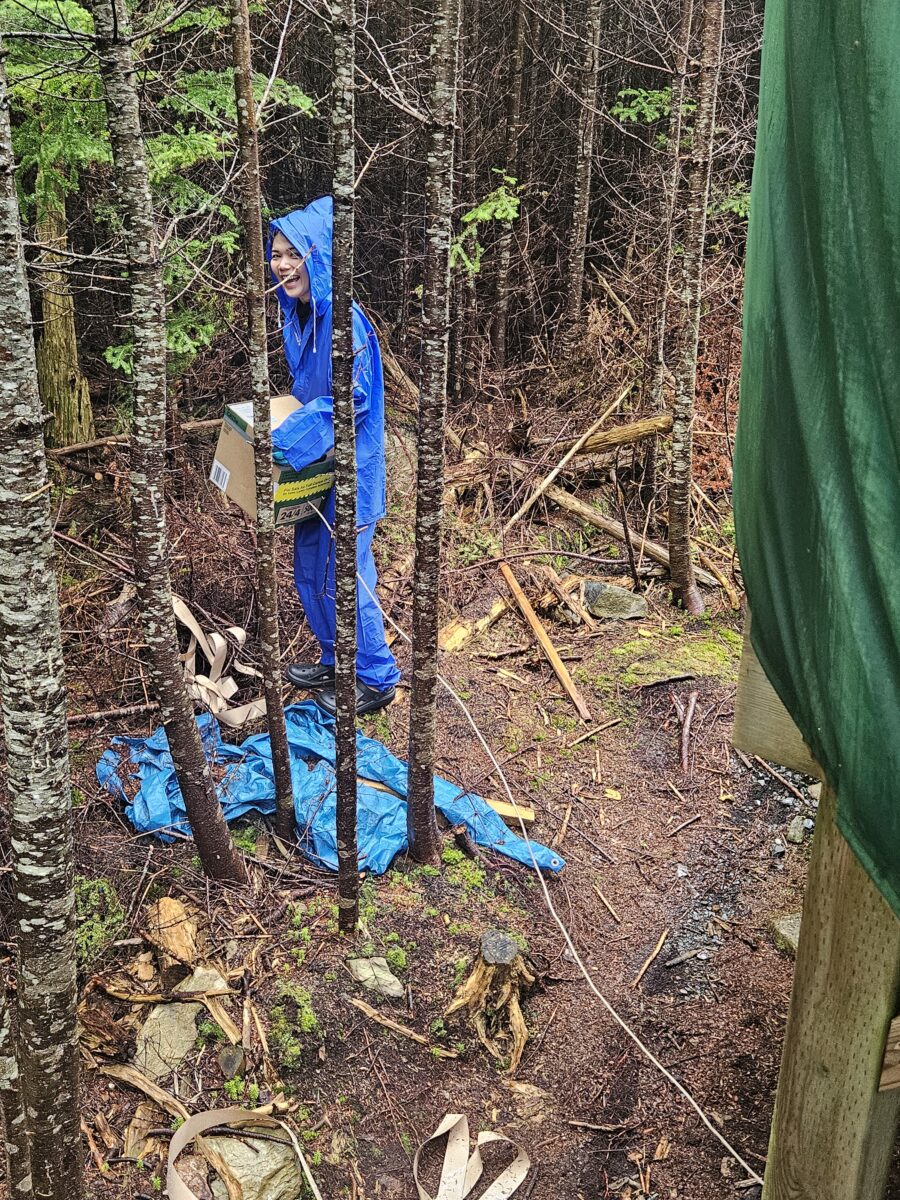
The last two days were mostly sunny, and we needed the roof to be dry to put on the rubber coating. We seam taped all of the 64+ seams and came up with a system for applying the goo. Two people would be on the roof with climbing harnesses and gri-gris. The person on top would have the big five gallon bucket of goo and would pour it onto a panel. The second person would have a roller and would roll it evenly across the panel. A third person would sit on top of the ladder poking out of the circle at the top of the yurt and would relay supplies to the people on ropes.
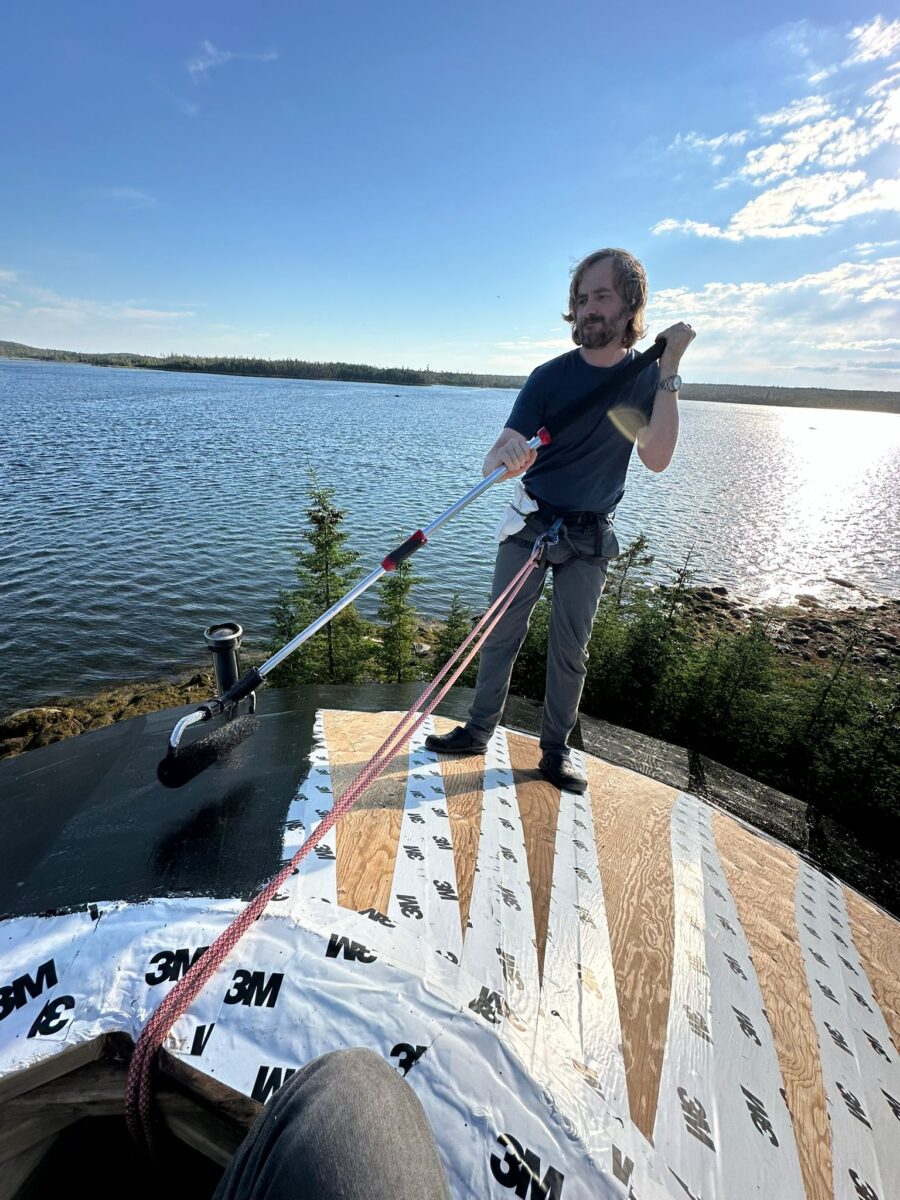
And… it worked. The wind got the goo everywhere, the sun had damaged some of the panels so it was hard to get even coverage, and we tried to mostly stand on the rafters, which was difficult. It was impossible not to paint oneself into a corner by the end, and as soon as the goo got on your shoes, they were like ice skates. The rollers we got sucked and would randomly break. We barely had enough parts by the end to combine them to have one that worked enough to paint the last two panels. In the end, we got a pretty good coating on there and we still have enough goo to do one more coat next year if we want to.
It rained a couple days before the coating, and water absolutely poured into the yurt. It got between the untaped seams of the wood and was concentrated by the old vinyl roof into several interior spouts. It rained the morning after we got the coating on and not a single drop got in.
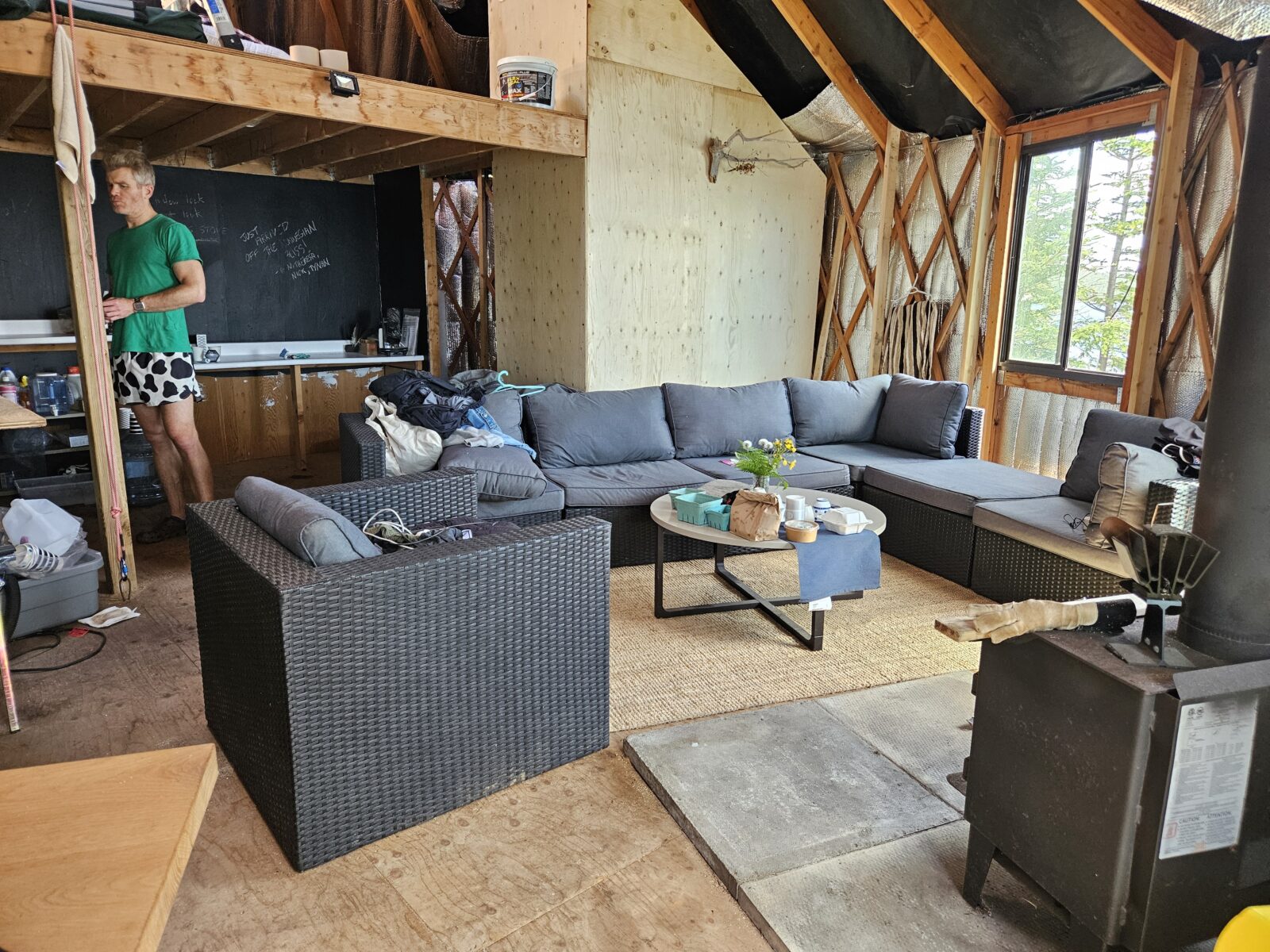
For the first time since Covid, the island is at an all time high. It’s waterproof, we have internet, and we can take hot indoor showers without flashing everyone in the living room. I dreaded the first roof trip, was nervous about the second one, but now I’m fired up an can’t wait to get back to the island. Now that the critical stuff is done we can work on better power, running water, interior walls, and upgrading the kitchen.
###
Photo on the top is the finished roof!
I just finished a truly epic and absurd project today after over a year (!) of intermitent work on it. It’s so ridiculous that I’m thinking about making a little youtube video about it as well as a blog post.
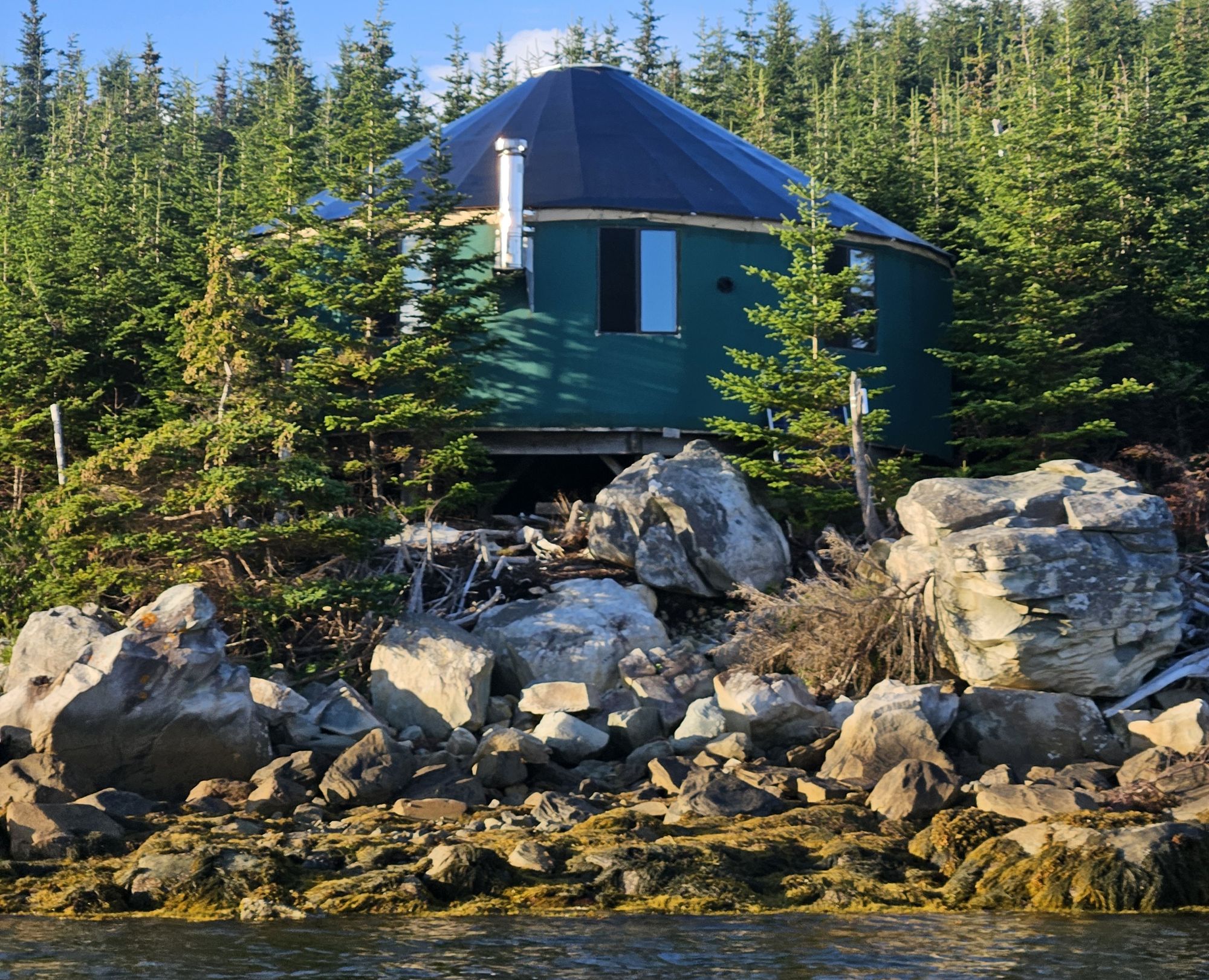
Leave a Reply